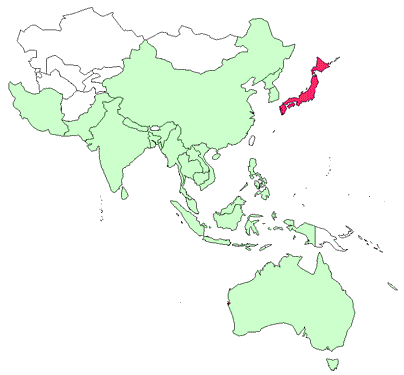Diseases of molluscs
Viral diseases—Akoya oyster disease
Signs of disease
Important: animals with disease may show one or more of the signs below, but disease may still be present in the absence of any signs.
Clinical signs of disease in an infected animal
- stunted growth
Gross signs of disease in an infected animal
- soft tissue atrophied and shrunken
- adductor muscle is yellowish to red (as opposed to the creamy white of healthy oysters)
Disease agent
Causative agent has not been identified, but is assumed to be viral.
Host range
Molluscs known to be susceptible to Akoya oyster disease:
Japanese pearl oyster (Akoya oyster)* (Pinctada fucata martensi)
*naturally susceptible
Presence in Asia–Pacific

Akoya oyster disease has been officially reported from Japan.
Epidemiology
- Akoya oyster disease is a disease of marine waters, and occurs at water temperatures above 20°C.
- The disease affects oysters more than one year old, and produces high mortality, particularly in summer and autumn.
- Susceptibility may vary with strains and subspecies of the Akoya oyster.
- Transmission is thought to be horizontal.
- The only effective control method is avoidance by restricting movement around high-risk areas and moving oysters to areas of cooler water during the summer.
Differential diagnosis
The differential diagnostic table and the list of similar diseases appearing at the bottom of each disease page refer only to the diseases covered by this field guide. Gross signs observed might well be representative of a wider range of diseases not included here. Therefore, these diagnostic aids should not be read as a guide to a definitive diagnosis, but rather as a tool to help identify the listed diseases that most closely account for the gross signs.
Similar diseases
This disease should be suspected when mass mortality occurs only in Akoya oysters.
Sample collection
Because of uncertainty in differentiating diseases using only gross signs, and because some aquatic animal disease agents might pose a risk to humans, you should not try to collect samples unless you have been trained. Instead, you should phone your national hotline number and report your observations. If samples have to be collected, the agency taking the call will advise you on what you need to do. Local or district fisheries/veterinary authorities could advise you on sampling.
Emergency disease hotline
For your national emergency disease hotline number, see Whom to contact if you suspect a disease.
Further reading
The currently accepted procedures for a conclusive diagnosis of Akoya oyster disease are summarised at http://library.enaca.org/Health/DiseaseLibrary/AkoyaDisease.pdf
This hyperlink was correct and functioning at the time of publication.

